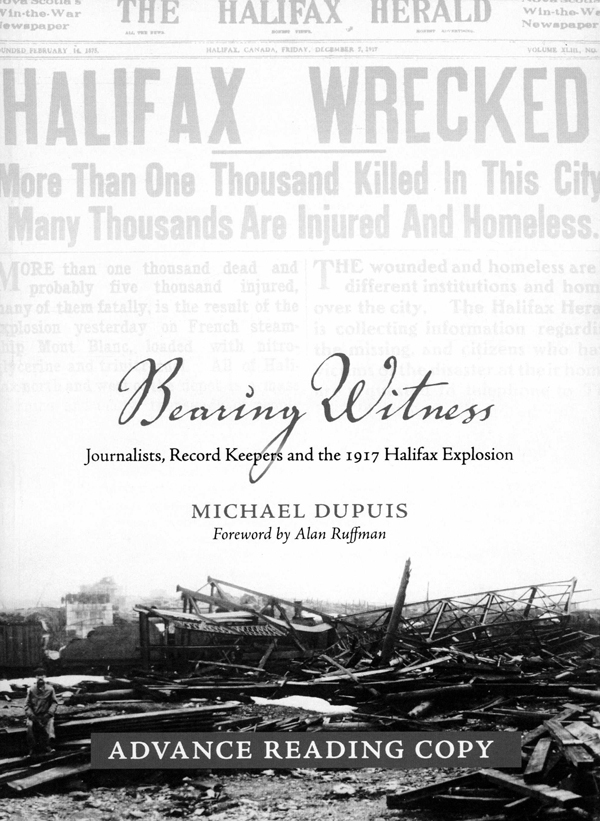Book examines Halifax Explosion through journalist accounts
By Lookout on Apr 29, 2017 with Comments 0

Peter Mallett, Staff Writer ~
Victoria author Michael Dupuis’ fascination with the Halifax Explosion has led to a 194-page book, Bearing Witness: Journalists, Record Keepers and the 1917 Halifax Explosion.
The retired history teacher’s latest literary work recounts one of the most infamous and defining moments in Canada’s history through stories of journalists covering the event.
“It’s been 100 years since the explosion and no one has really recognized the work of the journalists and how their words tell the entire story of what really happened in Halifax,” says Dupuis. “They were a major catalyst for the remarkable relief effort by Canadians and Americans that ensued.”
For two years Dupuis dug deep into the national archives, library microfilm, and interviews from that fateful morning of Dec. 6, 1917, to recapture the tireless efforts of more than 20 journalists from Canada and the United States whose job it was to tell the world about the grisly scene.
Many newspaper reports spell out in great detail the devastating 2.9-kiloton blast that occurred when Norwegian vessel SS Imo struck the munitions-laden French freighter SS Mont-Blanc in Halifax Harbour, causing a fire to break out that soon after ignited her cargo. The shockwave from the explosion resulted in a firestorm and tsunami that flattened four square miles and killed 2,000, injured more than 9,000, and left 12,000 homeless.
Dupuis notes in the opening passage that survivors first claimed “to see a blinding flash of light and giant fireball, then heard a horrendous, ear-slitting roar and crash.”
The book is dedicated to Halifax Daily Echo reporter John ‘Jack’ Ronayne who was the only journalist to die in the explosion.
“As soon as he heard Mont-Blanc was burning at Pier 6, Ronayne rushed to the scene,” said Dupuis. “When the munitions-laden ship suddenly and unexpectedly exploded he was very close to ground zero. Ronayne was severely injured and burned in the concussion wave and died a short time after, in the line of duty.”
Many reporters noted how a series of detonations from exploding barrels of benzol on Mont-Blanc resulted in countless Haligonians rushing to their windows to investigate the disturbance, and then how many were killed by flying glass from the second explosion.
Bearing Witness highlights some of the more well-known accounts of the disaster including a tribute by Alfred Coffin of the Truro Daily News to “heroic” Telegraph Operator Vince Coleman who “stuck at his key” at Richmond Station giving the news of the burning ammunition ship and how he “nobly remained at his post too long.”
The book also explores other not so well-known aspects of the Halifax Explosion, including the fierce blizzard that hit the day after the explosion. Dartmouth Patriot editor Joseph Sheldon’s described how the snowstorm created a “pathetic scene” as it swept over the wrecked buildings and the dead beneath.
Journalists also recounted in great detail the military angle as Halifax was the final departure and returning point for Canadian soldiers fighting in the First World War.
George Yates, Private Secretary to Prime Minister Robert Borden, said a returning soldier described post-blast Halifax as closely resembling “a town in Flanders [France]” while other accounts compared the scene in Halifax akin to some of Europe’s most deadly battlefields such as Ypres, and even the recent Battle of Vimy Ridge.
Yates also noted in another bulletin how many soldiers had hurried to the scene and how scores of military bodies were found close to Pier 6 “stripped of their clothing and sometimes even their flesh” in an unexpected “rendezvous with death.”
In a Dec. 20, 1917, Ottawa Citizen reporter Thomas T.P. Gorman covered a mass funeral for 20 sailors and soldiers attended by hundreds as a “pathetic picture of heroism and grief.”
There were also the survivor stories with a military theme. Chief among them was Grattan O’Leary of the Ottawa Journal who wrote in great detail about the rescue effort led by Lieutenant-Colonel McKelvey Bell, assistant director of medical services for the Canadian Armed Forces, and helping to create “order out of chaos.”
O’Leary also reported on the lives of 35 students at the city’s Naval College who were severely injured by flying glass but miraculously survived the blast. Meanwhile B.J. Donovan told a Toronto Star reporter that Naval Lieutenant Harold Parks, who was located only 100 yards from Mont-Blanc, but remarkably escaped death after being lifted off his feet and blown several yards before being driven through a thick wooden partition.
“Almost every journalist and record keeper described and commented on the actions and achievements of the military personnel,” says Dupuis. “In fact the military was the only organization to deal effectively with the rescue, relief, security, and many other community needs.”
Dupuis will give two presentations at the Oak Bay Public Library, May 3, 2 to 2:30 p.m., and at the main branch on Broughton Street, May 9 from 7 to 8:30 p.m. He will also attend an official book launch on June 3, 3 p.m., at the Maritime Museum of the Atlantic in Halifax.
The book can be ordered through Fernwood Publishing and obtained in Victoria at Munro’s and Bolen Books and at the University of Victoria bookstore. In Halifax it can be purchased at Bookmark, King’s Co-op and Chapters at Bayers Lake Power Centre.
He has also written extensively on the work of journalists including the Winnipeg general strike, On-to-Ottawa Trek, the Regina Riot, and the Titanic.
Filed Under: Top Stories
About the Author:





